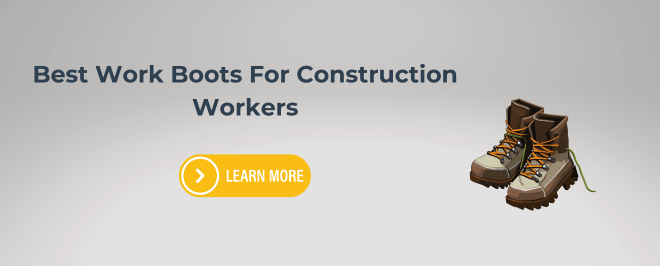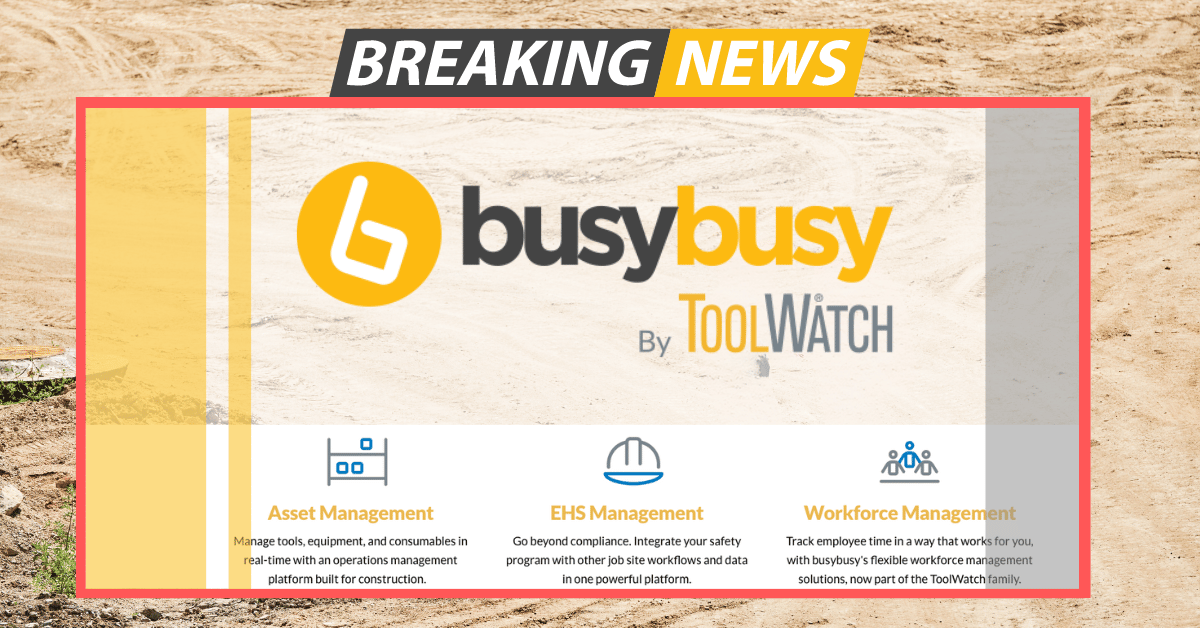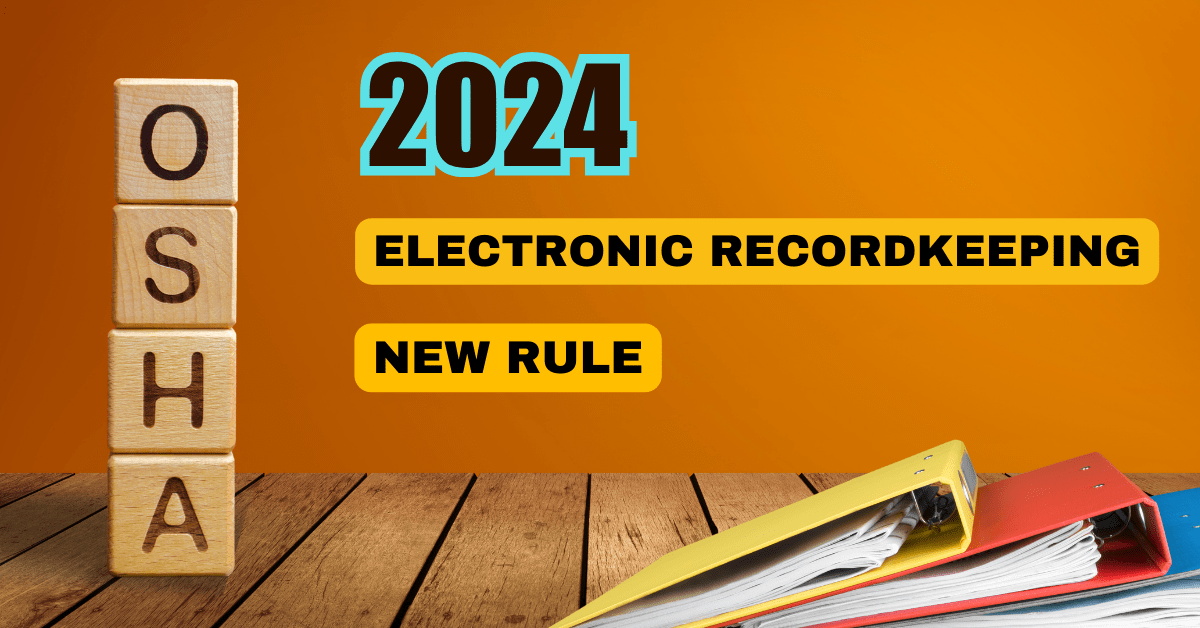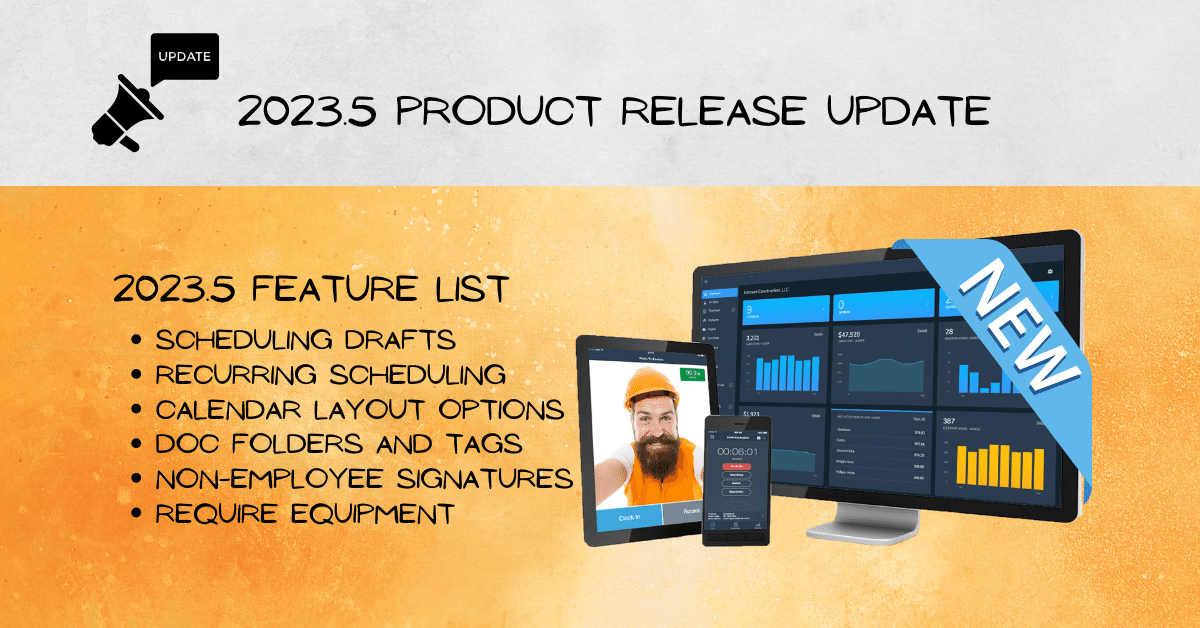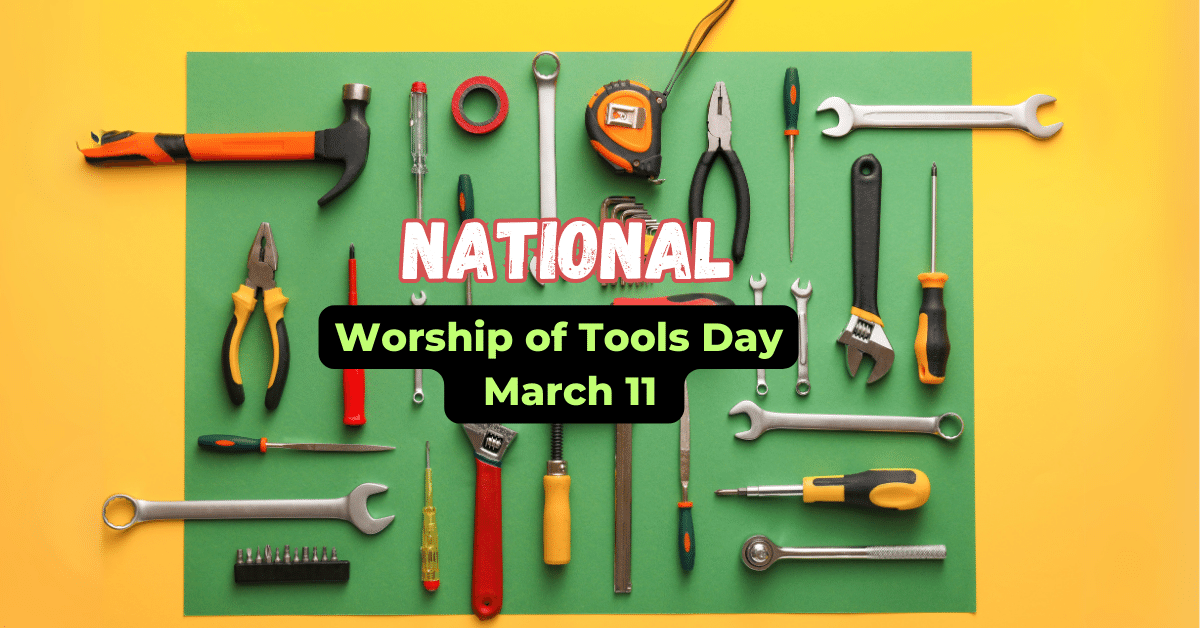
What is National Worship of Tools Day?
National Worship of Tools Day, observed on March 11th each year, is a lighthearted celebration dedicated to recognizing the importance of tools in our daily lives. It’s a day to honor the tools that help us build, create, and fix things, whether it’s in our homes or workplaces.
While the origins of this holiday are unclear, it serves as a fun opportunity to appreciate the utility and craftsmanship of tools while also acknowledging their significance in trades. Many people use this day to indulge in their love for tools, whether it’s by organizing their toolbox, shopping for new gadgets, or simply taking a moment to reflect on the role that tools play in their lives.
Whether you’re a seasoned DIYer, a professional tradesperson, or just someone who appreciates a well-made tool, National Worship of Tools Day offers a chance to celebrate and honor these essential instruments of innovation and productivity.
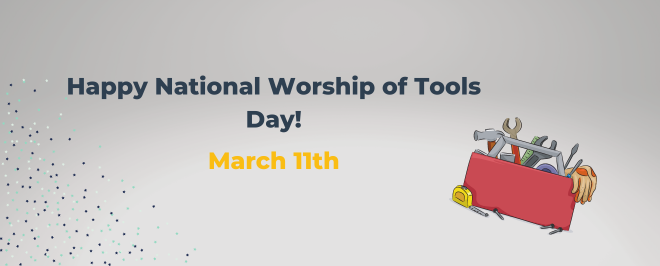
In honor of National Tool Day, we created a comprehensive guide including-
1 Understanding the Basics of Construction Tools
2 Types of Construction Tools and Their Uses
3 How to Maintain and Care for Construction Tools
4 Safety Measures When Using Construction Tools
5 Innovations in Construction Tools
In the world of construction, having the right tools at your disposal can make all the difference between a successful project and a challenging endeavor. From hand tools to heavy equipment, each tool serves a specific purpose in the construction process.
Construction tools are essential for any construction project, whether it’s a small home renovation or a large-scale commercial development. Before diving into the specific types of tools and their uses, it’s important to understand the basics of construction tools.
Understanding the Basics of Construction Tools
This section will cover the fundamental concepts and principles that underpin the world of construction tools.
1.1 What are construction tools?
Construction tools are devices, instruments, or machines used to perform various tasks in the construction industry. These tools are designed to aid in activities such as cutting, shaping, fastening, measuring, and moving materials. They are essential for tasks ranging from simple repairs to complex construction projects.
1.2 Importance of using the right tools
Using the right tools is crucial in construction projects for several reasons:
Efficiency and Productivity:
Appropriate tools help increase efficiency and productivity by simplifying tasks and reducing manual labor. They enable workers to complete tasks more quickly and effectively, saving time and resources.
Quality of Work:
Using the right tools ensures the quality of workmanship. Tools designed for specific tasks provide precision and accuracy, resulting in higher-quality outcomes.
Safety:
Using improper tools or neglecting safety protocols can lead to accidents and injuries. The right tools, combined with proper training and safety measures, minimize risks and create a safer working environment.
1.3 Basic terminology and functions
To understand construction tools better, it is essential to familiarize yourself with some basic terminology and their corresponding functions. Here are a few common terms you should know:
Cutting Tools:
These tools are used for cutting and shaping materials, such as saws, shears, and knives.
Fastening Tools:
Fastening tools help secure materials together, such as hammers, nails, screws, and drills.
Measuring Tools:
Measuring tools are used to ensure accuracy in construction, including tape measures, levels, and rulers.
Moving Tools:
These tools assist in moving heavy materials or equipment, such as wheelbarrows, dollies, and cranes.
Safety Tools:
Safety tools include personal protective equipment (PPE), such as hard hats, safety goggles, gloves, and ear protection.
1.4 Skills and knowledge required
Using construction tools effectively requires certain skills and knowledge. Some key skills include:
- Familiarity with tool operation and maintenance
- Ability to interpret construction plans and measurements
- Understanding of safety protocols and regulations
- Proficiency in using hand-eye coordination and spatial awareness
1.5 Importance of learning about construction tools
Learning about construction tools is vital for various individuals, including:
- Construction professionals: Contractors, builders, and tradespeople need in-depth knowledge of tools to execute their work effectively.
- DIY enthusiasts: Homeowners and hobbyists can save money and time by performing their own construction projects with the right tools and skills.
- Construction students: Learning about tools is a crucial part of construction education, providing a solid foundation for future careers in the industry.
Understanding the basics of construction tools is the first step towards becoming proficient in their use. With this knowledge, you can make informed decisions about tool selection and ensure efficient and safe construction practices.
2 Types of Construction Tools and Their Uses
Construction tools come in a wide variety of types, each designed for specific tasks and purposes. Understanding the different types of tools and their uses is essential for selecting the right tool for the job. In this section, we will explore the three main categories of construction tools: hand tools, power tools, and heavy equipment. We will delve into the specific tools within each category, their functions, and the tasks they are commonly used for.
2.1 Construction Hand Tools
Hand tools are manually operated tools that require physical effort from the user. These tools are commonly used in construction due to their versatility and ease of use. Here are some commonly used hand tools:
Hammer
A hammer is a handheld tool with a heavy head attached to a handle. It is primarily used for driving nails, removing nails, or striking objects. Hammers come in various sizes and styles, including claw hammers, ball peen hammers, and sledgehammers.
Screwdriver
Screwdrivers are used for tightening or loosening screws. They consist of a handle and a shaft with a tip that fits into the head of a screw. Screwdrivers come in different types, such as flathead, Phillips, and Torx, to accommodate different screw designs.
Wrench
Wrenches are tools used to tighten or loosen nuts, bolts, and other fasteners. They provide grip and leverage for rotating objects. Common types of wrenches include adjustable wrenches, socket wrenches, and open-end wrenches.
Pliers
Pliers are versatile hand tools used for gripping, bending, cutting, and holding objects. They have two handles joined at a pivot point, with jaws that can be flat, curved, or serrated depending on the intended use. Some common types of pliers include slip-joint pliers, needle-nose pliers, and locking pliers.
Chisel
Chisels are sharp-edged tools used for cutting, shaping, or carving materials such as wood or stone. They have a handle and a metal blade that is struck with a hammer or mallet to remove material or create precise cuts.
2.2 Construction Power Tools
Power tools are electrically or pneumatically powered tools that provide additional strength and speed compared to hand tools. These tools require a power source, such as electricity or compressed air, to operate. Here are some commonly used power tools in construction:
Circular Saw
A circular saw is a handheld power tool with a circular blade that spins rapidly to cut through various materials, including wood, plastic, and metal. It is commonly used for making straight cuts or angled cuts in construction projects.
Drill
A drill is a versatile power tool used for drilling holes or driving screws into different materials. It consists of a motor, a chuck to hold drill bits or screwdriver bits, and a handle for control. Drills come in different types, such as corded drills, cordless drills, and hammer drills.
Power Sander
A power sander is a tool used to smooth surfaces by abrasion. It uses a motor and sanding pads or belts to remove rough edges, paint, or coatings from materials like wood or metal. Common types of power sanders include orbital sanders, belt sanders, and detail sanders.
Nail Gun
A nail gun, also known as a nailer, is a power tool used to drive nails into various materials, such as wood or concrete. It operates by compressed air or electromagnetism and provides rapid and efficient nailing, saving time and effort compared to manual hammering.
Rotary Tool
A rotary tool is a handheld power tool with a rotating tip or bit that can be used for cutting, grinding, sanding, polishing, and engraving. It is compact and versatile, making it suitable for intricate tasks and detailed work.
2.3 Heavy Equipment
In larger construction projects, heavy equipment is often required to handle heavy loads, excavate, or perform specialized tasks. These machines are operated by trained professionals and are essential for completing complex construction projects efficiently. Here are some common types of heavy equipment used in construction:
Excavator
An excavator is a large machine with a rotating platform, a long arm, and a bucket for digging and moving soil, rocks, or debris. It is commonly used for excavation, demolition, and material handling in construction projects.
Bulldozer
A bulldozer is a powerful machine with a large blade at the front for pushing soil, debris, or other materials. It is primarily used for grading, leveling, and clearing land in construction sites.
Crane
A crane is a tall, lifting machine with a boom or arm and cables for hoisting and moving heavy objects vertically and horizontally. Cranes are crucial for tasks such as lifting steel beams, concrete panels, or machinery in construction projects.
Forklift
A forklift, also known as a lift truck, is a powered industrial truck with fork-shaped prongs at the front for lifting and carrying heavy loads. It is commonly used for material handling and logistics in construction sites and warehouses.
Concrete Mixer
A concrete mixer is a machine used for combining cement, sand, gravel, and water to create concrete. It ensures the proper mixing and consistency of concrete, making it an essential tool for construction projects involving concrete structures.
Understanding the different types of construction tools and their uses is crucial for selecting the right tool for each specific task. Whether it’s a simple repair or a complex construction project, having the appropriate tools on hand will greatly enhance efficiency and quality of work.
3 How to Maintain and Care for Construction Tools
Proper maintenance and care for construction tools are essential to ensure their longevity, optimal performance, and safety. Neglecting maintenance can lead to tool malfunctions, decreased efficiency, and even accidents. In this section, we will explore the best practices for maintaining and caring for construction tools, including regular cleaning and inspection, proper storage, and routine maintenance and repairs.
3.1Regular Cleaning and Inspection
Cleaning Tools
Regularly cleaning construction tools helps remove dirt, debris, and other contaminants that can affect their performance. Here are some tips for cleaning different types of tools:
- Hand Tools: Wipe down hand tools with a clean cloth after each use. For stubborn dirt or rust, use a wire brush or sandpaper to remove it. Apply a light coat of oil to prevent further rusting.
- Power Tools: Before cleaning power tools, always unplug them or remove the battery. Use a brush or compressed air to remove dust and debris from vents and moving parts. Wipe the tool’s surface with a damp cloth, and ensure it is completely dry before storage.
Inspection and Maintenance
Regularly inspecting construction tools helps identify any damage or wear that might affect their performance or safety. Here are some key areas to check during inspection:
- Hand Tools: Inspect hand tools for loose or damaged handles, rusted parts, or worn-out cutting edges. Replace or repair any damaged components promptly.
- Power Tools: Check power cords for frays or cuts and replace them if necessary. Inspect blades, bits, or attachments for signs of wear or damage and replace them as needed. Ensure all safety features, such as guards or switches, are functioning correctly.
3.2 Proper Storage
Properly storing construction tools is crucial for preventing damage, loss, or theft. Here are some storage tips to consider:
- Clean and dry tools before storage to prevent corrosion or rust.
- Store hand tools in a toolbox or on a pegboard, keeping them organized and easily accessible.
- Power tools should be stored in a dry, dust-free area, preferably in their original cases or in a designated tool cabinet or shelf.
- Use proper hooks, racks, or hangers to hang larger tools, such as shovels or rakes, to prevent bending or damage.
3.3 Routine Maintenance and Repairs
Performing routine maintenance and repairs on construction tools helps keep them in optimal working condition. Here are some maintenance tasks to consider:
- Lubricate moving parts of hand tools, such as hinges or joints, with appropriate lubricants.
- Sharpen cutting edges of tools like chisels, saws, or blades regularly to maintain their effectiveness.
- Replace worn-out or damaged parts promptly to avoid further damage or compromised safety.
- Follow the manufacturer’s guidelines for any specific maintenance or servicing requirements for power tools.
3.4 Documentation and Tool Tracking
Keeping track of your construction tools is essential for inventory management and preventing loss or theft. Here are some practices to consider:
- Create an inventory list of all construction tools, including their specifications, purchase dates, and serial numbers.
- Label tools with unique identifiers or markings to identify ownership and deter theft.
- Implement a tool sign-out system for tracking tool usage and ensuring accountability.
By following these maintenance practices, construction tools will remain in optimal condition, providing reliable performance and extending their lifespan. Properly cared for tools not only enhance productivity but also contribute to a safer work environment for construction professionals.
4 Safety Measures When Using Construction Tools
Safety is of utmost importance when using construction tools. The improper use of tools or failure to follow safety protocols can result in accidents, injuries, or even fatalities. In this section, we will explore the essential safety measures to consider when working with construction tools. These measures include using personal protective equipment (PPE), safe handling and use of tools, and preventing accidents and injuries.
4.1 Personal Protective Equipment (PPE)
Head Protection
Wear a hard hat to protect your head from falling objects, overhead hazards, or accidental impacts.
Eye and Face Protection
Wear safety goggles or a face shield to protect your eyes and face from flying debris, dust, or chemical splashes.
Hand Protection
Wear work gloves appropriate for the task to protect your hands from cuts, abrasions, burns, or chemical exposure.
Foot Protection
Wear safety boots or steel-toed shoes to protect your feet from falling objects, heavy equipment, or potential punctures.
Hearing Protection
Use earplugs or earmuffs in noisy environments to protect your ears from prolonged exposure to loud noises that can cause hearing damage.
Respiratory Protection
Use respiratory masks or respirators when working with hazardous materials, chemicals, or in environments with poor air quality.
4.2 Safe Handling and Use
Read and Follow Instructions
Always read and understand the manufacturer’s instructions and safety guidelines before using any tool. Follow proper operating procedures and adhere to recommended safety precautions.
Use Tools for Their Intended Purpose
Use tools only for their intended purpose and within their designated capacities. Avoid using tools in ways they were not designed for, as this can lead to accidents.
Maintain a Stable Work Area
Ensure your work area is clean, well-lit, and free from clutter or obstacles. Maintain a stable footing and secure any materials or equipment to prevent tripping or falling hazards.
Use Proper Body Mechanics
Use proper body mechanics to avoid strains or injuries. Lift heavy objects with your legs, not your back, and avoid overreaching or overexerting yourself.
Secure Workpieces
Secure workpieces properly before working on them to prevent unexpected movements or slips that can cause accidents.
4.3 Preventing Accidents and Injuries
Tool Inspection
Regularly inspect tools for any signs of damage, wear, or malfunction. Do not use damaged or faulty tools, as they can pose a safety risk.
Electrical Safety
When using power tools, ensure that electrical cords are in good condition, properly grounded, and away from water or other hazards. Avoid overloading circuits and use ground fault circuit interrupters (GFCIs) when necessary.
Lockout/Tagout Procedures
Follow lockout/tagout procedures when servicing or repairing tools to prevent accidental startup or release of stored energy.
Work Area Security
Secure work areas to prevent unauthorized access, especially in construction sites with heavy equipment or hazardous materials.
Training and Education
Ensure that all individuals using construction tools receive proper training on their safe operation and understand the associated hazards. Provide ongoing education and updates on safety protocols and best practices.
By following these safety measures, construction professionals can minimize the risk of accidents and injuries while working with tools. Prioritizing safety not only protects individuals but also contributes to a more efficient and productive work environment.
5 Innovations in Construction Tools
The field of construction tools is constantly evolving, driven by advancements in technology, sustainability, and the demand for increased efficiency. In this section, we will explore the latest innovations in construction tools, including technological advancements, eco-friendly options, and future trends that are shaping the industry.
5.1 Technological Advancements
Power Tool Upgrades
Power tools are becoming smarter and more efficient with the integration of advanced technologies. Features such as brushless motors, smart sensors, and wireless connectivity enhance performance, durability, and user experience.
Laser Technology
Laser technology is revolutionizing construction tools, particularly in the areas of leveling, measuring, and layout. Laser levels, distance measurers, and laser-guided equipment provide precise and efficient measurements, reducing human error and saving time.
Robotics and Automation
Robotic technology is increasingly being used in construction, particularly for tasks that are repetitive, dangerous, or require high precision. Automated bricklaying robots, drones for surveying and inspections, and autonomous equipment are transforming the construction industry.
Construction Software
Gone are the days when you arrive at a jobsite without a contractor using some form of construction technology. Architectects utilize BIM software, contractors use busybusy for workforce management, and safety inspectors use safety reports to improve compliance with OSHA.
The recent advancements in construction technology has revolutionized efficiency across job sites.
5.2 Eco-friendly Tools
Green Materials
The focus on sustainability has led to the development of eco-friendly construction tools that use recycled or renewable materials. Tools made from recycled plastic, bamboo, or wood from sustainably managed forests help reduce environmental impact.
Energy-efficient Power Tools
Energy-efficient power tools, such as those with low power consumption or rechargeable batteries, are gaining popularity. These tools help reduce energy consumption, lower operating costs, and decrease carbon emissions.
Noise-reducing Tools
Construction sites are known for their loud and noisy environment. Noise-reducing tools, such as quieter compressors, electric-powered equipment, or vibration-dampening technology, provide a more comfortable and less disruptive work environment.
5.3 Future Trends
Augmented Reality (AR)
Augmented Reality (AR) is making its way into construction tools, offering benefits such as enhanced visualization, on-site guidance, and improved project coordination. AR-enabled tools provide real-time data overlays, 3D modeling, and virtual simulations for better project planning and execution.
Internet of Things (IoT)
The Internet of Things (IoT) is transforming the construction industry by connecting tools, equipment, and devices to a network. IoT-enabled tools allow for remote monitoring, predictive maintenance, and data-driven decision-making, leading to increased productivity and efficiency.
3D Printing
3D printing technology is revolutionizing construction by allowing for the creation of complex and customized components. It enables rapid prototyping, cost-effective construction, and the ability to create intricate architectural designs.
Innovations in construction tools are not only improving productivity and efficiency but also contributing to sustainability and safety. As technology continues to advance, we can expect further developments in construction tools, enabling construction professionals to work smarter, faster, and with reduced environmental impact. Staying informed about these innovations and embracing new tools can give construction projects a competitive edge and lead to more sustainable and successful outcomes.
In Conclusion
In conclusion, National Worship of Tools Day serves as a fun reminder of the invaluable role that tools play in our lives, both personally and professionally. Whether you’re a seasoned DIYer or a professional tradesperson, this day offers an opportunity to celebrate and appreciate the utility, craftsmanship, and innovation behind our favorite tools.
As we honor this special day, let’s also channel our enthusiasm into furthering our knowledge and skills with a comprehensive guide to mastering construction tools. From understanding the basics to exploring the latest innovations, there’s always something new to discover in the world of tools. So, let’s roll up our sleeves, grab our favorite tools, and embark on a journey of learning, creativity, and productivity. Happy National Worship of Tools Day!




